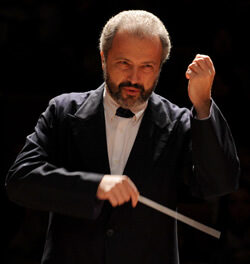In this year of the Winter Games, is there a Gold Medal available for consistent and invaluable support and encouragement of uncommonly talented young music students? If so, it rightly belongs to the committed musicians of the Raleigh Symphony Orchestra. And for furnishing the venue, much student talent, and lending powerful backing for such an enterprise, what about a shout-out for the Meredith College Department of Communication and Performing Arts?
These orchestral forces provided two similar presentations on a single weekend, beginning on Saturday evening with the “Meredith College Concerto Aria Competition” in Jones Auditorium on the campus. Before the competition winners came on, conductor Jim Waddelow elicited a full-throated orchestral sound from Symphony No. 7 of Sibelius. The dark hues opening this “half-length” symphony were reminiscent of the composer’s earlier great Second Symphony.
Sophomore Mary Beth Cameron brought on the first of the two arias. This pure unaffected soprano voice was flawless in Almirena’s intense aria, “Lascia, ch’io pianga” from Handel’s Rinaldo; she could work on her dramatic delivery. Senior soprano Rosanna Turchi was powerfully effective, furnishing the requisite passion and grief to Juliet’s “Oh! quante volte” from Bellini’s opera version of Romeo and Juliet (I Capuleti e i Montecchi). (Here the orchestra and harp accompaniment was most impressive, given that this piece is almost certainly not a part of their standard repertory.)
Senior Lane Creech chose Charles Tomlinson Griffes’ Poem for Flute and Orchestra from 1918 as the vehicle to demonstrate her considerable solo skills. This flutist turned graceful phrases in this near-impressionistic work and was masterly in negotiating its occasional technical demands.
In a procedure such as this, someone always stands out for “bravery.” This time it was senior Katherine Barton in her choice of the Intermezzo and Allegro vivace movements of Schumann’s monumental Piano Concerto, Op. 54, a work essayed by every great pianist who has ever lived (since 1845). The crowd-pleasing pianist proved equal to the task, carefully caressing the lyrical Intermezzo and rising to the demands of the fast movement. Her stage presence seemed that of a veteran.
***
Now here less than one day after the Saturday evening program, these same musicians show up at the same venue for yet another major supporting role, Sunday afternoon edition. This time the program is identified as the players’ stated favorite, “Rising Stars,” wherein are presented the two winners of the Raleigh Symphony’s annual statewide concerto competition.
After a spirited rendition of the National Anthem, Music Director Waddelow and the players reprised the opener from the previous evening, the aforementioned elegant Symphony No. 7 of Sibelius.
Violinist Mary Catherine Cox is a junior at East Carolina University. She brought “pro” qualities to the huge Allegro Moderato first movement of Tchaikovsky’s “singing” Violin Concerto in D. Without seeing such an accomplished performer in action, one cannot fully appreciate the demands of this movement and its enormous cadenza. Over fifty years ago in discussing a newly discovered young violinist, the critic noted “…a sure left hand, a sensitive, supple bow arm and a tone of color and plasticity.” Perhaps such superior characteristics can readily apply to this latter day young violinist.*
“All the youthful freshness is there, and yet it plays itself so much more easily.” So spoke Rachmaninoff when discussing the re-write of his Piano Concerto No. 1, Op. 1. Pianist Daniel Liauw might take issue with that part about the piece playing itself. This UNC-Chapel Hill senior chose the blazing Vivace movement of this work to show some prodigious pianism. Always in control, he showed that he can “drive” with the Tigers of the world. Since the movement lacks the enduring melodies and peaceful passages of other Rachmaninoff works, it was hard to assess this pianist’s “short game” abilities. But all indications point to an extraordinary level of excellence.
So the judges have spoken: It’s perfect 10’s all around for the Raleigh Symphony Orchestra. And the non-profit sponsors of this program are due great thanks and generous support from one and all. These organizations are Wounded Warriors, Boys and Girls Clubs and Helping Paws.
*For a review of violinist Cox at ECU, click here.











